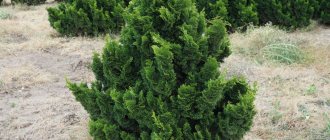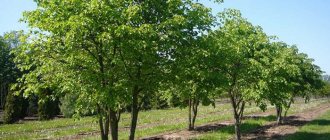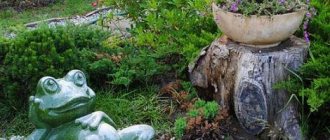Description of the plant and species
@tursar.ru
The tree belongs to the legume family and grows to a decent size. The height of the tree can reach 25 meters. A wide variety of plant species suggests the presence of both tall and formed trees and spreading shrubs with many branches.
The roots of the plant extend deep into the ground. In the upper layers they branch heavily, but inside they grow straight.
In varieties that are represented by trees, the trunk reaches a meter in diameter. It can be painted in light or dark colors, depending on the age of the plant. Brown, gray, green or even brown when the acacia is old enough. Some types of flowering shrubs are studded with sharp thorns.
The leaves are oval in shape and resemble an egg in outline. At the top they are soft green in color and absolutely smooth, while at the bottom they are gray and rough. The flowers of the plant are especially attractive.
They are represented by snow-white or yellowish buds, collected in large inflorescences. Different species have a special arrangement and shape of inflorescences. There are panicles, racemes or cylindrical inflorescences looking upward.
For traditional medicine, acacia fruits are of particular value. They are burgundy-colored pods that usually contain five bean seeds. Based on them, various decoctions and infusions are made to treat diseases.
The following types of plants are distinguished:
- Curved. It grows in the vastness of Australia and reaches a height of six meters. The branches are long, grow at an acute angle, the elongated leaves reach a length of seven centimeters, and the inflorescences on a high stalk contain at least 12 spherical heads.
- Double-edged. Grows up to three meters in height with widely spaced branches. The leaves are long, slightly narrowed at the base. The flowers are single, arranged in a chaotic manner, attached to long stalks.
- Veinless. In Australia it is considered a forage plant. It quickly grows to a height of up to seven meters and is covered with large leaves and single inflorescences with lush, double yellow flowers. It grows in the driest areas, thanks to which it quickly becomes food for livestock.
- Leafless. Grows in thickets of eucalyptus forests. Its peculiarity is the complete absence of green foliage on the bush. It reaches a height of no more than two and a half meters, has a large number of yellow spherical flowers on numerous branches. Belongs to the endangered species of acacia.
- Ashby. Spreading bush, reaching two meters in width and height. It is covered with long light green leaves, and spherical flowers are concentrated at the ends of the branches.
- Variegated. A creeping bush that conquers its place with sharp centimeter-long thorns, randomly located along the branches of the acacia tree. The inflorescences are spikelets with small white flowers, their length reaches eight centimeters.
- Bailey. A profusely flowering yellow acacia, which is distinguished by lush inflorescences with small spherical flowers that dot the branches of the tree.
There are many more types of acacia around the world. Some of them are protected by sharp thorns, others have incredible beauty and aroma. Each gardener decides for himself which option to choose for his garden.
Care
Young trees need regular moisture, while mature bushes require water only during drought. Shrub acacia takes enough moisture from incoming precipitation. For irrigation, use water at room temperature; water the planting in the morning or evening. After watering, slight loosening of the soil is necessary.
Top dressing
The plant does not require fertilizers for the first three years. Older trees are fed with special preparations during the flowering period and in mid-summer. 100 g of fertilizer is enough for one plant, which is scattered near the root and sprinkled with soil. At the end of summer, you can use 30 g of potassium sulfate or a glass of wood ash per acacia tree.
Features of care during the flowering period
The plant needs regular watering and constant sunlight. There is no need for additional spraying of the tree. The flowering period of acacia is the best time to apply fertilizers with a high content of potassium and phosphorus.
Features of care in spring
Water should not stagnate, and loosening the soil is also not recommended. You can weed around the acacia tree to remove weeds. The soil should not be drained, because the bush plant will enrich it with nitrogen on its own.
White acacia fragrant clusters
Preparing the plant for winter
Acacia is frost-resistant, it can withstand temperatures below -25 degrees, but for the first three years the bush must be covered for the winter. In the autumn season, when all the leaves have fallen and it gets colder outside, you can begin preparing for frost. Peat or fallen leaves are poured onto the root area, the tree is wrapped in burlap and secured until spring.
Beginning gardeners are still confused: is acacia a tree or a shrub? It all depends on the variety and type. The planting is in demand due to its beautiful flowers, unique fragrance and valuable red wood. When purchasing a plant, you should ask the seller for a complete description of the acacia shrub and the rules for caring for it.
Waffle iron GFgril GF-010,
1510 ₽ More details
Waffle iron GFgril GFW-015, red
2990 ₽ More details
Steamers GFgril
What species are acacias confused with?
Often, plants that are commonly called acacia do not belong to this genus of plants at all. They are also part of the legume group and look like a tree-like shrub, but they are still not acacia.
Latin names and abbreviations that are assigned to plants will help you distinguish plants. So, for example, white and pink acacias belong to the genus Robinia. Lankaran acacia belongs to the genus Albizia, and yellow acacia is caragana. Sand acacia belongs to the genus Ammodendron, which is far from the acacia family.
@blog-travushka.ru
Notes
Latin name "Albizia"
comes from the surname of an Italian nobleman, Filippo del Albizzi, who brought the plant to Europe in the mid-18th century.
The name “julibrissin”
comes from the ancient Persian language, meaning “silk flower”, where
jul
= “flower”,
abrisham
= “silk”.
Because the plant drops its leaves at night, it is known in Asia by its standard name "sleeping tree
».
General characteristics of albizia, conditions for growing indoors and in the garden, recommendations for replanting and propagation, diseases and pests, interesting facts, species.
This legume bears its name in honor of one of the members of the Albizia family - Filippo del Albizzi (it sounds like Filippo degli Albizzi in Italian), who lived in the first half of the 18th century. Filippo belonged to a very old and powerful family, which even competed with the Medici in the lands of Florence. It was he who brought Albizia from Constantinople to Europe in 1740, so the flower received the name of its discoverer - Albizia julibrissin (that is, Albizia Lankaran).
The plant is often popularly called “Mimosa” or “Acacia”; it really is very reminiscent of well-known flowering species. And also, given its coming from the lands of today’s Istanbul (which is what ancient Constantinople is now called), albizia is called “Constantinople acacia.” Another name was given to it in ancient times by the Persians “gul-i abrisham” - combining the words gul-i, which meant “flower” and abrisham, translated as “silk” and the result was “silk flower”, “silk acacia”, “silk tree” "or "silk bush".
Representatives of this family are characterized by spherical inflorescences; the flowers that comprise them are distinguished by elongated stamens. Basically, the plant has a tree or shrub growth form. The height of the albizia can reach 10 meters with a width of 7 meters. There are specimens that live up to 50–100 years. Mature trees have a spreading crown with umbrella-shaped shapes. The shoots have slight pubescence. The bark has a dark brown tone.
The leaf blades have double-pinnate outlines, they are decoratively openwork, shaded with light green tones. The length of the leaf can reach 20–30 cm. With the arrival of the autumn-winter period, the leaves of Albizia fall off.
The flowering process occurs in July-August. From the flowers, inflorescences are collected in the form of corymbose panicles (they have a spherical shape) or bottle-shaped spikelets, which from a distance seem fluffy. The inflorescences are located in the leaf axils. The color of the buds is yellowish-whitish. Stamens protruding beyond the petals are pink in color. Flowers can become a source for obtaining fragrant, light-colored honey.
After flowering, the leguminous fruits ripen. Their length can be close to 20 cm, they usually grow from 6 to 12 seed beans. When dry pods sway under gusts of wind, they emit a characteristic sound similar to a whisper, and because of this, in Burma the tree is called “chatty tongue” or in the English variation “woman's tongue”.
Medicinal properties and contraindications of acacia
In addition to its magnificent appearance, the shrub has medicinal properties, which distant ancestors knew about. When talking about medicinal properties, we mean one type of acacia - white robinia. It is this plant that has valuable components in its composition.
The active substance of the plant is considered to be the glycoside robinin.
It actively reduces the content of nitrogenous substances in the patient’s blood and also has a hepatoprotective effect. This is important if the patient develops acute renal failure. The flowers contain dozens of flavonoids, many of which are used to create hangover-relieving pills.
The bark of the plant contains tannins, which are actively used to treat bacterial infections. And the leaves and flowers of acacia contain essential oils. They are widely used in herbal medicine and perfumery.
Treatment with folk remedies based on acacia is prohibited for pregnant and lactating women, children under 12 years of age, as well as people with individual intolerance to the components of the substance.
Silk tree in landscape design
Indoor spurge - white-veined, cypress and other types
Due to the decorative properties of silk acacia, the tree is often used in the work of landscape designers.
The crown of silk acacia is not very thick, so decorative flowers can be planted under it. The leaves retain their green color until frost.
Albizia in landscape design
Acacia albizia can be used to create compositions in urban environments, as it is not afraid of polluted air.
Application
The flowers of the plant have pronounced properties:
- diuretics;
- antipyretic;
- astringents;
- relieve spasms;
- choleretic.
Infusions and decoctions are used for urolithiasis, acute respiratory infections, colds, myositis, osteochondrosis and joint pain, as well as inflammatory processes in the intestines, genitals and urinary system.
Beekeepers claim that honey made from acacia pollen has special properties.
Fauna of the Tula region
The world of birds is located on the treetops. Most often you can find rooks, swifts, woodpeckers, ducks, sparrows, swallows and others there.
Rivers and lakes are full of their own life. They are inhabited by pike, roach, scaly carp, carp and catfish. Bream, perch, chub, ide and asp are also often found.
One of the rarest and most valuable fish is sterlet.
Collection, preparation and storage
@moleskines-shop.ru
Acacia flowers are considered the main source of nutrients. They are collected as soon as they begin to bloom. After collection, they are laid out on a tarpaulin and dried in the shade under natural conditions or in a dryer at a temperature of up to 50 degrees.
The bark and leaves are harvested from late April to early September. Spread on the surface in a thin layer and dry in natural conditions, periodically turning over or stirring. Blackening or molding of leaves is not allowed. Such copies should be thrown away.
The bark of the plant is poisonous, so precautions should be taken when collecting and processing.
The resulting components must be stored in clean cardboard boxes or canvas bags. The shelf life is no more than three years.
Biological features
Attitude to light : photophilous, in the middle zone it requires a place open to the sun for shoots to ripen, and in warmer conditions it can tolerate light partial shade.
Relation to moisture : drought-resistant, does not tolerate stagnation of water, with prolonged waterlogging the roots dry out and the plant dies. The groundwater level should be below 2 m.
Attitude to soil : undemanding to soil fertility, but prefers loose, well-drained, uncompacted soil with neutral acidity (pH 6.5-7.5).
Relation to temperature : easily tolerates summer heat up to 40 degrees. The natural species is winter-hardy, withstands frosts up to 35 degrees.
Reproduction methods
Acacia has two methods of reproduction on its site. You can take cuttings from an adult plant or try to grow acacia from seeds.
Growing from seeds
In this case, the efforts of the gardener will be required. To begin with, the seeds are evaporated by placing them in hot water, the temperature of which is not lower than 80 degrees. The shell is carefully cut with a sharp, pre-sterilized knife. This way, young shoots will appear on the surface much faster.
Cuttings
@7dach.ru
This method is much easier to implement, even for a person who does not understand gardening. You can use root cuttings or pieces of branches that are germinated in a glass of warm water. The main thing is that the cutting is about 10 cm in size.
First, it is kept in a nutrient substrate or complex fertilizer, and then planted in a container and placed in a greenhouse. After rooting, the seedling is planted in open ground. This can be done in the fall during the same season.
How to replant Albizia Constantinople
Transplantation of a deciduous plant is carried out before sap begins to flow and buds open. This is usually done in early March. Young specimens are replanted annually. Starting from the age of three, transplantation is carried out every two to three years. Sometimes plant replanting is compensated by replacing the top layer of soil. This technique is only suitable for adult acacias.
Albizia is a rapidly growing crop and needs a spacious flowerpot. Acacias need a loose, well-ventilated substrate. Among industrial soil mixtures, soil for decorative deciduous crops is suitable. Experienced gardeners prefer to prepare their own ingredients for the soil mixture. Home soil is prepared by mixing calcined sand with turf soil and crushed peat in a ratio of 1:3:2.
A high-quality layer of drainage material should be laid at the bottom of the flowerpot for good drainage of excess moisture. Methods and rules for propagating ornamental bushes
There are two most common methods of breeding Albizia Lankaran:
- seed germination;
- planting shoots;
- rooting cuttings.
The first method is used if seed material is available and does not present much trouble. Productivity depends on the freshness of the seeds. Cuttings are resorted to when there are no acacia beans at hand.
Propagation by seeds is not very difficult and consists of the following:
- Seeds must be stratified within two days. Both hot and cold methods are used to speed up the emergence of sprouts from seeds.
- The swollen seeds are embedded shallowly in a moist peat substrate.
- The bed is covered with polyethylene to maintain high humidity.
- The first shoots appear two to three months after sowing.
Reproduction of albizia by basal shoots is simple and highly productive. The only problem is that under indoor conditions, growths appear extremely rarely. It is recommended to remove it so that the planting does not thicken. These sprouts are separated from the root system with a small part of the root and planted in a separate pot. The seedlings quickly take root in their new location.
It is extremely important to thoroughly disinfect the cut with a fungicide or activated carbon powder. Reproduction of acacia of Constantinople by cuttings allows you to obtain a new specimen in the absence of seed material
Suitable branches are selected from waste after formative pruning or cut directly from the tree. It is recommended to select semi-lignified one- to two-year-old shoots.
The length of the cutting varies between 10-15 centimeters. Excess leaves are removed, leaving two or three. The remaining leaf blades are shortened to reduce moisture loss. The branches are planted in the substrate and put away in a cool place. Rooting of cuttings lasts one to two months. Experienced gardeners treat cutting cuttings with growth stimulants to speed up the process of root germination.
Rooted cuttings are planted in separate pots in early autumn. Subsequent care does not differ from that generally accepted for this culture.
Diseases and pests
@lesoteka.com
Acacia is quite resistant to various types of diseases, infections and harmful insects. However, if the plant is not provided with optimal growing conditions, it may get sick. Pests can be removed manually or you can use industrial pesticides that quickly kill pests on the bush.
Putrefactive and fungal pathologies are eliminated with Bordeaux mixture, but only after removing all affected branches and leaves. After treatment, the plant will gradually gain strength and begin to bloom again.
ATTENTION!
The information on the site is for informational purposes only and does not call for action. Remember, self-medication can harm your health. Before using medicinal herbs, consult your doctor.
Flora of the Tula region
The Tula region is enriched with vegetation. In various areas there are forests, meadows, swamps and steppes. The Tula region can be divided into forest-steppe zones and zones of broad-leaved trees.
It cannot be said that there are many forests in the Tula region, but some part can still be identified.
In the northwest, deciduous forests predominate, in which oaks, birches, aspens, maples, poplars and others are most often found. Swamps often form among them.
The vegetation of fields, steppes and meadows is diverse, but mainly it consists of weed species. The soil of these places is suitable for wild radish, white pigweed, field and garden thistle, milkweed, meadow chamomile and a huge number of weeds and shrubs.
Shrubs of the Moscow region: names
This group includes not only domesticated cultivated plants. Wild shrubs of the Moscow region also widely inhabit local biotopes. The most common among the cultural forms that fill summer cottages and gardens are fruit and berry species.
Among the wild-growing organisms of this group, we can distinguish such as euonymus, wolfberry, dogwood, bladderwort, maple, lilac, Middendorf weigela, elderberry, broom, dogwood, rhododendron, forsythia, oleaster, peony, rowan, roses, almonds, hawthorn, willow, barberry and others.
Spirea
Wild shrubs of the genus Spiraea include about 90 species. Some of them have long been cultivated by people and are very widely used for landscaping areas.
Types of middle spirea, the most common in the nature of Russia, are beautiful wild-growing shrubs, photos of which can be seen below.
The following representatives are also very popular:
Spectacular bushes strewn with fragrant bright inflorescences can leave few people indifferent, this explains the popularity of the plant. It has practically no medicinal value.
Shrubs of Russia
Wild shrubs in our region are distinguished by great species diversity. They are widespread in all zones and latitudes, form deciduous and partly coniferous forests, and line hills and mountain ranges. Also among them there are many representatives that people use for decorative purposes in garden plots. Berries of some types are actively consumed as food and are valued for their vitamin components. Wild shrubs in Russia even have medicinal forms.
The most common species growing in the wild are:
The wild shrubs of our region are very beautiful, diverse in their role in nature and significance for humans. There are a number of species that people strive to plant and propagate on their plots of land for different purposes: decorative, nutritional, landscape design. Such representatives include the following wild trees and shrubs: bird cherry, blueberry, apple tree, ash, rose hip, thuja, pine, spruce, currant, plum, lilac, rowan, broom, nightshade, alder, sea buckthorn, juniper, raspberry, pear, hazel , viburnum, barberry, grapes, linden, lemongrass, gooseberry, buckthorn, maple, honeysuckle, oak and others.
Wild shrubs of the Urals
The flora of the Urals, the Urals, Siberia and the Far East is very similar in the species composition of shrub forms. Thus, common species in these areas are quince, barberry, elderberry, weigela, wolfberry, dogwood, gorse, honeysuckle, willow and other plants.
All of them form the general appearance of the nature of fields and meadows, forests. Thanks to plants such as wild shrubs and trees, the picture of the natural habitat of animals and people becomes complete, capacious, beautiful and varied.
You can give a short list of those species of the Urals that are basic for these places. These are wild shrubs, the names of which are given below.











